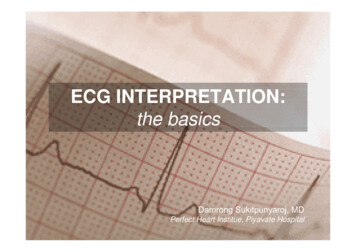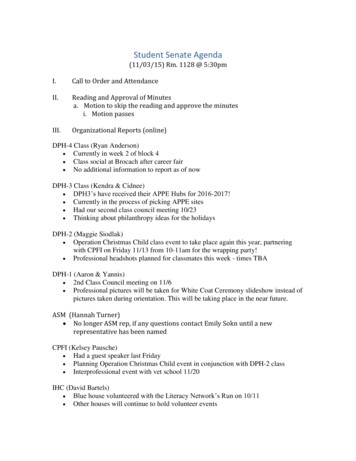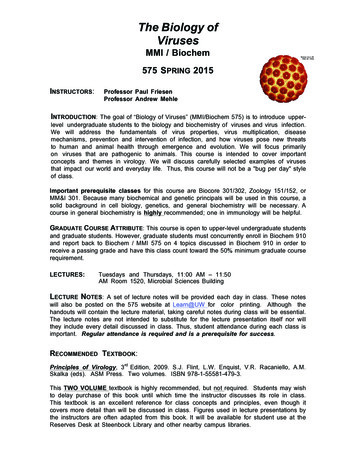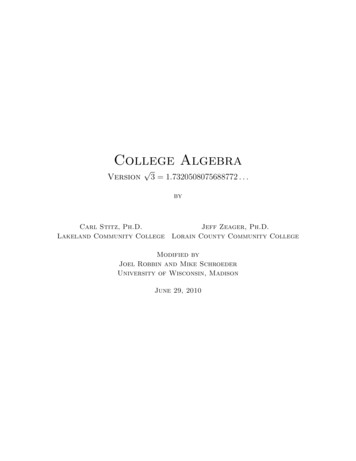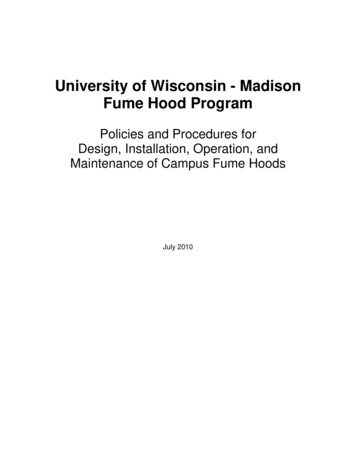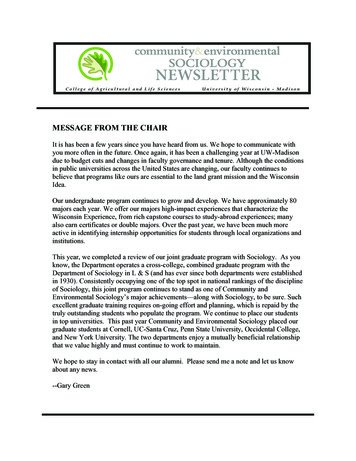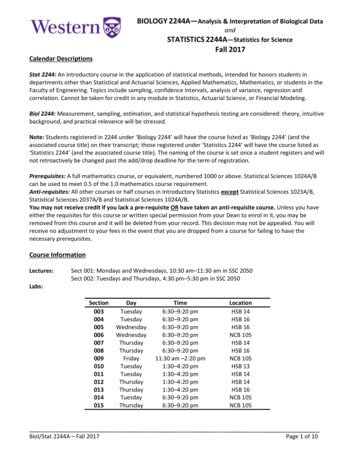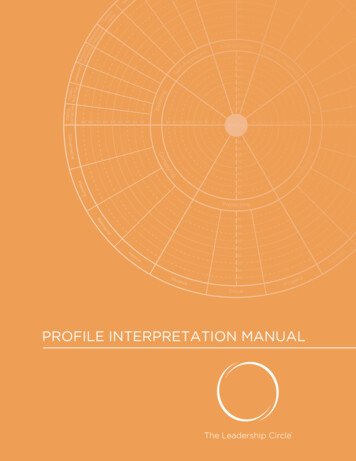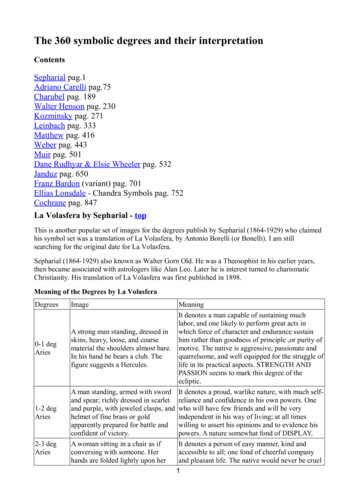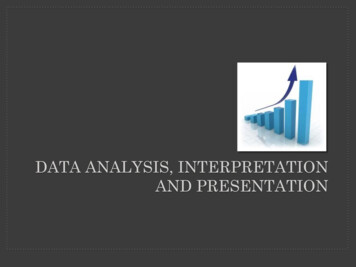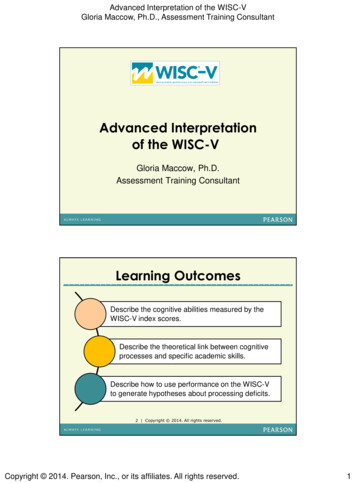
Transcription
Advanced Interpretation of the WISC-VGloria Maccow, Ph.D., Assessment Training ConsultantAdvanced Interpretationof the WISC-VGloria Maccow, Ph.D.Assessment Training ConsultantLearning OutcomesDescribe the cognitive abilities measured by theWISC-V index scores.Describe the theoretical link between cognitiveprocesses and specific academic skills.Describe how to use performance on the WISC-Vto generate hypotheses about processing deficits.2 Copyright 2014. All rights reserved.Copyright 2014. Pearson, Inc., or its affiliates. All rights reserved.1
Advanced Interpretation of the WISC-VGloria Maccow, Ph.D., Assessment Training ConsultantConceptual Structure4 Copyright 2014. All rights reserved.Copyright 2014. Pearson, Inc., or its affiliates. All rights reserved.2
Advanced Interpretation of the WISC-VGloria Maccow, Ph.D., Assessment Training ConsultantWISC-V Index Scores andContributing Cognitive ProcessesFull Scale IQ Most reliable score – good predictor of important life outcomes. Derived from a sum of 7 subtest scaled scores. Considered the score that is most representative of global intellectualfunctioning (g).6 Copyright 2014. All rights reserved. Traditionally, FSIQ has been the first score to be considered in profileinterpretation.6 Copyright 2014. All rights reserved.Copyright 2014. Pearson, Inc., or its affiliates. All rights reserved.3
Advanced Interpretation of the WISC-VGloria Maccow, Ph.D., Assessment Training ConsultantPrimary Index ScalesThe primary index scores, along with the FSIQ, are recommended fora comprehensive description and evaluation of intellectual ability.7 Copyright 2014. All rights reserved.Abilities Measured byPrimary Index ScalesIndexAbilities MeasuredVerbal Comprehension Word Knowledge AcquisitionInformation RetrievalAbility to reason and solve verbal problemsCommunication of knowledgeVisual Spatial Visual spatial reasoningSynthesis of part-whole relationshipsAttentiveness to visual detailVisual-motor integrationFluid Reasoning Inductive and Quantitative ReasoningBroad Visual IntelligenceSimultaneous ProcessingAbstract Thinking8 Copyright 2014. All rights reserved.Copyright 2014. Pearson, Inc., or its affiliates. All rights reserved.4
Advanced Interpretation of the WISC-VGloria Maccow, Ph.D., Assessment Training ConsultantAbilities Measured byPrimary Index ScalesIndexAbilities MeasuredWorking MemoryAbility to register, maintain, and manipulate visualand auditory information in conscious awareness. Attention Concentration Mental ControlProcessing Speed Short-term visual memoryVisual-Motor CoordinationVisual DiscriminationVisual ScanningConcentrationCognitive FlexibilityRate of Test-Taking9 Copyright 2014. All rights reserved.Ancillary Index Scales Derived from combinations of primary subtests or primary andsecondary subtests.10 Copyright 2014. All rights reserved. Provide additional informationregarding a child’s cognitive abilities andWISC–V performance.10 Copyright 2014. All rights reserved.Copyright 2014. Pearson, Inc., or its affiliates. All rights reserved.5
Advanced Interpretation of the WISC-VGloria Maccow, Ph.D., Assessment Training ConsultantComplementary Index ScalesComplementary scales were designed to enhance the11 Copyright 2014.All rights reserved.assessment of childrenwithlearningdifficulties.11 Copyright 2014. All rights reserved.Generate HypothesesTwelve Male – Grade 6(See WISC-V Score Report)Copyright 2014. Pearson, Inc., or its affiliates. All rights reserved.6
Advanced Interpretation of the WISC-VGloria Maccow, Ph.D., Assessment Training ConsultantReasons for ReferralHis teachers report that Twelve has difficulty– listening and following directions,– reading grade-level text with comprehension,– meeting expectations in the preparation ofcompositions or written responses to demonstratewhat he has learned, and– completing long-term assignments (i.e., bookreports).Often, he is talking when he should be working.13 Copyright 2014. All rights reserved.Reasons for ReferralHis parents report similar concerns at home.– Twelve often does not remember his chores, or hestarts his chores and does not complete them.– He complains about assigned reading and refuses attimes to complete written assignments.14 Copyright 2014. All rights reserved.Copyright 2014. Pearson, Inc., or its affiliates. All rights reserved.7
Advanced Interpretation of the WISC-VGloria Maccow, Ph.D., Assessment Training ConsultantDemographic Information15 Copyright 2014. All rights reserved.Full Scale IQ andPrimary Index Scores16 Copyright 2014. All rights reserved.Copyright 2014. Pearson, Inc., or its affiliates. All rights reserved.8
Advanced Interpretation of the WISC-VGloria Maccow, Ph.D., Assessment Training ConsultantSubtest Scores17 Copyright 2014. All rights reserved.Primary AnalysisWorking Memory is a weakness relative to the MIS.18 Copyright 2014. All rights reserved.Copyright 2014. Pearson, Inc., or its affiliates. All rights reserved.9
Advanced Interpretation of the WISC-VGloria Maccow, Ph.D., Assessment Training ConsultantPrimary Analysis19 Copyright 2014. All rights reserved.Primary AnalysisSignificant and unusual discrepancy betweenVCI-WMIVSI-WMIFRI-WMIWMI-PSI20 Copyright 2014. All rights reserved.Copyright 2014. Pearson, Inc., or its affiliates. All rights reserved.10
Advanced Interpretation of the WISC-VGloria Maccow, Ph.D., Assessment Training ConsultantPrimary Analysis21 Copyright 2014. All rights reserved.Ancillary Indexes22 Copyright 2014. All rights reserved.Copyright 2014. Pearson, Inc., or its affiliates. All rights reserved.11
Advanced Interpretation of the WISC-VGloria Maccow, Ph.D., Assessment Training ConsultantQuantitative Reasoning Index (88)AR Requires computational abilityand quantitative knowledge. Loads on FRI, WMI, and VCI.10FW Requires math in a more limited, abstractmanner. Examinee uses quantitative concept of equalityto understand relationship among objects.616 Then, examinee applies concepts of matching,addition, and/or multiplication to identify correctresponse.23 Copyright 2014. All rights reserved.Auditory Working Memory Index (81)6 WMI is based on the multi-componentmodel. Two domain-specific storage systems:– phonological loop, and– visual-spatial sketchpad.713The AWMI is a purermeasure of auditoryworking memory.24 Copyright 2014. All rights reserved.Copyright 2014. Pearson, Inc., or its affiliates. All rights reserved.12
Advanced Interpretation of the WISC-VGloria Maccow, Ph.D., Assessment Training ConsultantNonverbal Index (106) 11Useful when examinee hasobvious verbal difficulties13– ELL10– RELD, ELD– ASD with LanguageImpairment101110 The processing speedcomponent can affect resultsjust like FSIQ.65 More emphasis on reasoningusing visual-spatial processesthan FSIQ.25 Copyright 2014. All rights reserved.25 Copyright 2014. All rights reserved.General Ability Index (109)1112131110The GAI provides anestimate of generalintellectual ability that isless reliant on workingmemory and processingspeed than the FSIQ.5726 Copyright 2014. All rights reserved.Copyright 2014. Pearson, Inc., or its affiliates. All rights reserved.13
Advanced Interpretation of the WISC-VGloria Maccow, Ph.D., Assessment Training ConsultantCognitive Proficiency Index (98)610101339The CPI provides anestimate of theefficiency with whichinformation is processedin the service oflearning, problemsolving, and higherorder reasoning.27 Copyright 2014. All rights reserved.Ancillary Analysis28 Copyright 2014. All rights reserved.Copyright 2014. Pearson, Inc., or its affiliates. All rights reserved.14
Advanced Interpretation of the WISC-VGloria Maccow, Ph.D., Assessment Training ConsultantComplementary Indexes29 Copyright 2014. All rights reserved.Naming Speed Index The NSI provides a broad estimate ofautomaticity of basic naming ability drawn froma variety of tasks. These tasks were developed to enhance theassessment of children with suspected learningdisabilities and are not designed as measuresof intellectual ability.30 Copyright 2014. All rights reserved.Copyright 2014. Pearson, Inc., or its affiliates. All rights reserved.15
Advanced Interpretation of the WISC-VGloria Maccow, Ph.D., Assessment Training ConsultantSymbol Translation Index The STI provides a broad estimate of visualverbal associative memory drawn from a varietyof conditions. These measures were developed to enhancethe assessment of children suspected of havinglearning problems or declarative memoryimpairment. These subtests were not developed asmeasures of intellectual ability.31 Copyright 2014. All rights reserved.Storage and Retrieval Index The SRI provides a broad estimate of long-termstorage and retrieval accuracy and fluency. It is derived from a variety of tasks designed toassess cognitive processes that are associatedwith reading, mathematics, and writing skills,and that have shown sensitivity to specificlearning disorders and other clinical conditions.32 Copyright 2014. All rights reserved.Copyright 2014. Pearson, Inc., or its affiliates. All rights reserved.16
Advanced Interpretation of the WISC-VGloria Maccow, Ph.D., Assessment Training ConsultantComplementary Analysis33 Copyright 2014. All rights reserved.Process Analysis34 Copyright 2014. All rights reserved.Copyright 2014. Pearson, Inc., or its affiliates. All rights reserved.17
Advanced Interpretation of the WISC-VGloria Maccow, Ph.D., Assessment Training ConsultantDeriving Contrast Scores35 Copyright 2014. All rights reserved.Interpreting Contrast ScoresSee Appendix C in the WISC-V Technical and Interpretive Manual.36 Copyright 2014. All rights reserved.Copyright 2014. Pearson, Inc., or its affiliates. All rights reserved.18
Advanced Interpretation of the WISC-VGloria Maccow, Ph.D., Assessment Training ConsultantProcess Analysis37 Copyright 2014. All rights reserved.Academic AchievementBased on his WISC-V profile,what are your hypothesesabout Twelve’sacademic achievement?38 Copyright 2014. All rights reserved.Copyright 2014. Pearson, Inc., or its affiliates. All rights reserved.19
Advanced Interpretation of the WISC-VGloria Maccow, Ph.D., Assessment Training ConsultantCognitive Processes Contributingto Academic SkillsReading-Related ProcessesContributing Processes Phonological Processing Rapid Naming Auditory Working Memory Language Comprehension Executive Functions Visuospatial Abilities40 Copyright 2014. All rights reserved.Copyright 2014. Pearson, Inc., or its affiliates. All rights reserved.20
Advanced Interpretation of the WISC-VGloria Maccow, Ph.D., Assessment Training ConsultantCognitive Processes and Reading Verbal comprehension and working memorywere the best WISC–III/WISC–IV predictors ofreading ability. Children diagnosed with SLD-R show reducedverbal working memory (Kibby & Cohen, 2008)and processing speed deficits (Shanahan etal., 2006).41 Copyright 2014. All rights reserved.Cognitive Processes and Reading Rapid automatic naming measures, similar toNaming Speed Literacy, significantly predictreading ability in both younger and older childrenwith reading disorder (Park & Lombardino, 2013). Children with reading disorders perform poorly onverbal learning measures (Kibby & Cohen, 2008)and on paired associate learning tasks that involvepairing a visual input (i.e., a symbol) with a verbalresponse, that is, a word or nonword (Litt & Nation,2014; Messbauer & de Jong, 2003).42 Copyright 2014. All rights reserved.Copyright 2014. Pearson, Inc., or its affiliates. All rights reserved.21
Advanced Interpretation of the WISC-VGloria Maccow, Ph.D., Assessment Training ConsultantSpecial Group Study Results:Specific Learning Disorder-Reading N 30ScoreClinicalMeanControlMeanMean DiffP valueStd. 710.5711.0713.0311.6314.1713.149.6314.55 .01 .01 .01 .01.02 .01 .01 .01 .01 .01 .01 .01 .01 343 Copyright 2014. All rights reserved.Math-Related ProcessesContributing Processes Attention Visual-Spatial Processing Working Memory Language Comprehension Executive Functions44 Copyright 2014. All rights reserved.Copyright 2014. Pearson, Inc., or its affiliates. All rights reserved.22
Advanced Interpretation of the WISC-VGloria Maccow, Ph.D., Assessment Training ConsultantCognitive Processes and Math Difficulties in verbal comprehension, workingmemory, and processing speed (Willicutt et al.,2013). General cognitive functioning, processing speed, andcomponents of working memory are longitudinalpredictors of math achievement (Geary, 2011). Difficulties with working memory (Geary, 2010),attention (Raghubar et al., 2009), and semanticretrieval and visuospatial skills (Cirino, Morris, &Morris, 2007) are related to mathematics difficulties.45 Copyright 2014. All rights reserved.Cognitive Processes and Math Early number skills and conceptual reasoning skillspredict math achievement (Fuchs, Geary, Compton,Fuchs, Hamlett, & Bryant, 2010). Language, nonverbal reasoning, and attention aresignificantly related to performance on math wordproblems (Fuchs, Geary, Compton, Fuchs, Hamlett,Seethaler, et al., 2010; Tolar et al., 2012).46 Copyright 2014. All rights reserved.Copyright 2014. Pearson, Inc., or its affiliates. All rights reserved.23
Advanced Interpretation of the WISC-VGloria Maccow, Ph.D., Assessment Training ConsultantSpecial Group Study Results:Specific Learning Disorder-Math N 28ScoreClinicalMeanControlMeanMean DiffP valueStd. 6.1114.449.713.7910.078.25 .01 .01 .01.07.03 .01 .01.02 .01 .63.23.63.5547 Copyright 2014. All rights reserved.WIAT-III ScoresComposite/SubtestStandard Score Percentile RankBasic Reading Word Reading Pseudoword Decoding879084192514Reading Comprehension andFluency Reading Comprehension Oral Reading Fluency879388193221Mathematics Math Problem Solving Numerical Operations110110108757570Written Expression Spelling Sentence Composition Essay Composition82788890127212548 Copyright 2014. All rights reserved.Copyright 2014. Pearson, Inc., or its affiliates. All rights reserved.24
Advanced Interpretation of the WISC-VGloria Maccow, Ph.D., Assessment Training ConsultantIntegration of DataRelative StrengthsRelative WeaknessesVerbalReasoningAuditory ocessingAbstractThinkingReading DecodingSpeed ofProcessingSpellingMath49 Copyright 2014. All rights reserved.EligibilityIs Twelve eligible for directspecialized instruction?50 Copyright 2014. All rights reserved.Copyright 2014. Pearson, Inc., or its affiliates. All rights reserved.25
Advanced Interpretation of the WISC-VGloria Maccow, Ph.D., Assessment Training ConsultantAbility–Achievement51 Copyright 2014. All rights reserved.Cognitive Hypothesis Testing52 Copyright 2014. All rights reserved.Copyright 2014. Pearson, Inc., or its affiliates. All rights reserved.26
Advanced Interpretation of the WISC-VGloria Maccow, Ph.D., Assessment Training ConsultantCognitive Hypothesis TestingProcessing StrengthWISC-V Visual-Spatial IndexSS 105A. Discrepant?Yes/NoAchievement WeaknessWIAT-III SpellingSS 78B. Discrepant?Yes/NoProcessing WeaknessWISC-V Naming Speed IndexSS 7853 Copyright 2014. All rights reserved.Another Set of DataCopyright 2014. Pearson, Inc., or its affiliates. All rights reserved.27
Advanced Interpretation of the WISC-VGloria Maccow, Ph.D., Assessment Training ConsultantLook at the Data What questions do you have? Should you compute the ancillary indexes?Why or Why Not? Look at the pattern of scores. Consider abilitiesshared by several subtests and abilities uniqueto a subtest. What follow-up testing would you recommend?55 Copyright 2014. All rights reserved.Male, Grade 5, Age 10:5WISC-VIndex/SubtestVerbal ComprehensionComposite Score/Scaled ScoreWISC-VIndex/SubtestComposite Score/Scaled Score8876Working MemorySimilarities6Digit Span6Vocabulary5Picture Span10(Information)(7)(Letter-Number Sequencing)(5)(Comprehension)(6)Processing Speed86Visual Spatial86Coding5Block Design5Symbol Search10Visual Puzzles10(Cancellation)(9)Fluid Reasoning103Matrix Reasoning11Figure Weights10(Picture Concepts)(Arithmetic)9(13)Full Scale IQ 7756 Copyright 2014. All rights reserved.Copyright 2014. Pearson, Inc., or its affiliates. All rights reserved.28
Advanced Interpretation of the WISC-VGloria Maccow, Ph.D., Assessment Training ConsultantWhat Are Your Hypotheses Now?Verbal Domain SubtestScaled ScoreSimilarities6Similarities Multiple Choice12Comprehension6Comprehension Multiple Choice15Vocabulary5Vocabulary Multiple Choice10Picture Vocabulary Multiple Choice10Information7Information Multiple Choice7(WISC-V Integrated, 2015)57 Copyright 2014. All rights reserved.Summary Generate hypotheses based on referralconcern. Identify patterns in the WISC-V data. Confirm or refute hypotheses. Generate follow-up questions. Determine what needs to be done to answerquestions.58 Copyright 2014. All rights reserved.Copyright 2014. Pearson, Inc., or its affiliates. All rights reserved.29
Advanced Interpretation of the WISC-VGloria Maccow, Ph.D., Assessment Training ConsultantCustomer Service1-800-627-7271 (USA)1-866-335-8418 (Canada)Webinar-Specific QuestionsGloria Maccow, yright 2014. Pearson, Inc., or its affiliates. All rights reserved.30
Broad Visual Intelligence Simultaneous Processing Abstract Thinking . Advanced Interpretation of the WISC-V . storage and retrieval accuracy and fluency. . pairing a visual input (i.e., a symbol) with a verbal res
